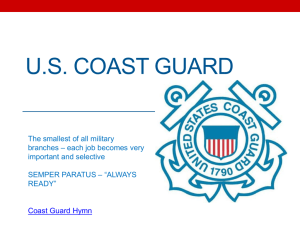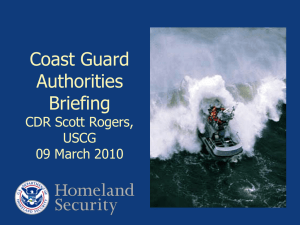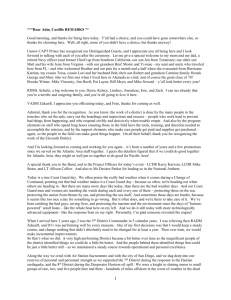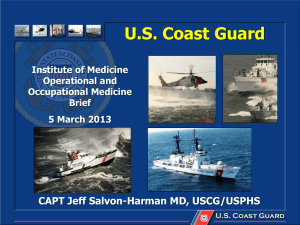Written Statement
advertisement
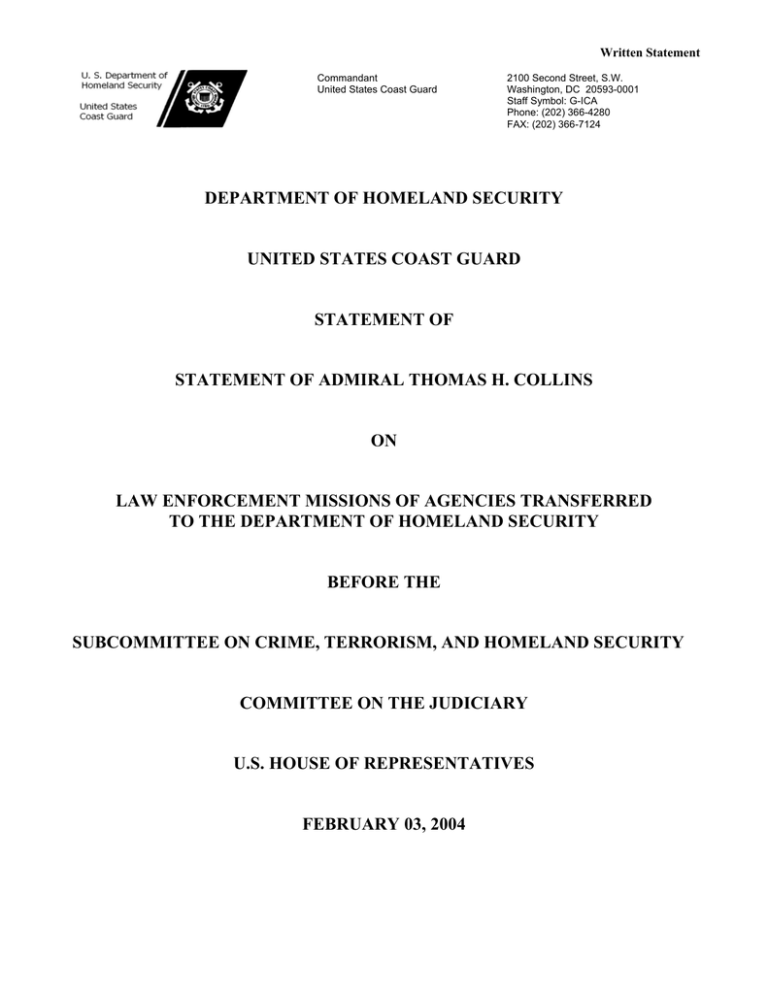
Written Statement Commandant United States Coast Guard 2100 Second Street, S.W. Washington, DC 20593-0001 Staff Symbol: G-ICA Phone: (202) 366-4280 FAX: (202) 366-7124 DEPARTMENT OF HOMELAND SECURITY UNITED STATES COAST GUARD STATEMENT OF STATEMENT OF ADMIRAL THOMAS H. COLLINS ON LAW ENFORCEMENT MISSIONS OF AGENCIES TRANSFERRED TO THE DEPARTMENT OF HOMELAND SECURITY BEFORE THE SUBCOMMITTEE ON CRIME, TERRORISM, AND HOMELAND SECURITY COMMITTEE ON THE JUDICIARY U.S. HOUSE OF REPRESENTATIVES FEBRUARY 03, 2004 Written Statement DEPARTMENT OF HOMELAND SECURITY UNITED STATES COAST GUARD STATEMENT OF ADMIRAL THOMAS H. COLLINS ON LAW ENFORCEMENT MISSIONS OF AGENCIES TRANSFERRED TO THE DEPARTMENT OF HOMELAND SECURITY BEFORE THE SUBCOMMITTEE ON CRIME, TERRORISM, AND HOMELAND SECURITY COMMITTEE ON THE JUDICIARY U.S. HOUSE OF REPRESENTATIVES FEBRUARY 03, 2004 Good afternoon Mr. Chairman and distinguished members of the Committee. It is a pleasure to appear before you today to discuss the law enforcement missions of the United States Coast Guard, and how we interact with our partners in the Department of Homeland Security (DHS). Shortly before the Coast Guard was transferred to the DHS on March 1, 2003, I briefed you on the transition and what that would mean for our law enforcement missions. It has been nearly a year since the Department of Homeland Security was created and I am happy to report that the transition is going as planned. The Coast Guard has preserved its essential qualities as a military, multi-mission and maritime service, and retains the full range of our missions. The importance of this cannot be overstated. Threats to the security of our homeland extend beyond overt terrorism. Countering illegal drug smuggling, preventing illegal migration via maritime routes, protecting living marine resources from foreign encroachment, implementing the provisions of the Maritime Transportation Security Act are all critical elements of national and economic security, and they are all Coast Guard responsibilities. The Coast Guard provides the Department of Homeland Security extensive regulatory and law enforcement authorities governing ships, boats, personnel and associated activities in our ports, waterways and offshore maritime regions. We are also one of the five armed military services, with a robust, around-the-clock command, control, communications, and response capability. We maintain, at the ready, a network of coastal small boats, aircraft, deep-water cutters, and expert personnel to prevent and respond to safety and security incidents. The Coast Guard is a statutory member of the national foreign intelligence community, and brings extensive intelligence gathering, analysis, and coordination experience to the new department. These attributes, which served our law enforcement and other missions well in the past, enable us to be the lead federal agency for Maritime Homeland Security. The Coast Guard has utilized its unique capabilities since September 11, 2001, to support the DHS missions, including providing direct and indirect support to combatant commanders executing Operations Iraqi Freedom and Liberty Shield. We remain focused on performance-based results. For example, in fiscal year 2003 the Coast Guard seized 62.1 metric tons of cocaine valued at nearly $4.4 billion, the second highest seizure total ever. The Coast Guard also noticed a significant reduction in foreign fishing vessel incursions of the U.S. Exclusive Economic Zone along the maritime boundary line that the U.S. shares with Russia. In 2003, only six incursions of the EEZ were noted Written Statement along the line; down sharply from the 22 detected in 2002. This sharp decline in EEZ incursions is attributed to two factors; increased presence of U.S. Coast Guard and Russia Federal Security Service enforcement assets, and a change in U.S. policy authorizing the use of warning shots and disabling fire as an enforcement tool. One piece of enacted legislation critical to improving law enforcement performance is the Maritime Transportation Security Act (MTSA) of 2002. MTSA has brought many new requirements and initiatives that enable a more coherent maritime security strategy. The requirement for port, vessel, and facility security plans provides increased vigilance through additional security forces and sensors and thus deters illegal activity. TSA's development of the Transportation Worker Identification Credential (TWIC) program may further assist in reducing illegal activities in and around the ports. In addition, the vetting of crew and passenger lists through intelligence and law enforcement databases has improved the process of allocating law enforcement resources to the highest threats. The MTSA has also authorized many new capabilities for the Coast Guard that enhances law enforcement performance. For example, Maritime Safety and Security Teams (MSSTs) have been created to provide a critical port security deterrence and response posture. They include the use of canines and divers that can be used to detect narcotics and explosives hidden on board vessels, or parasitic explosive devices attached to their hulls. Like our law enforcement partners, the Coast Guard is capitalizing on the synergies available through organizational relationships within the Department of Homeland Security. We have worked with many of these entities on law enforcement operations for decades, but we have capitalized on new opportunities to improve those working relationships by our common mission focus, which transitioned seamlessly as we all moved into the new department. We are already participating in a department-wide effort to develop information exchange requirements. We have begun the process through an exchange of personnel at the U. S. Customs and Border Protection (CBP) National Targeting Center and the Coast Guard Intelligence Coordination Center (part of the National Maritime Intelligence Center) to coordinate information on cargo and crew on commercial vessels. This will ultimately lead to a system in which every agent in the Department of Homeland Security has access to the same law enforcement information in real time. Consolidating our information will ensure legitimate people and cargo are screened more quickly, and allow our enforcement agents to stay focused on higher threat targets. As an example of our re-invigorated partnerships, Coast Guard personnel and agents from the CBP recently executed another successful interdiction near the Texas-Mexico border. A Coast Guard helicopter spotted a go-fast vessel two miles southeast of South Padre Island, TX. The local CBP office was notified, a Coast Guard small boat was launched from a shore station, and a patrolling cutter launched a second boat to pursue the go-fast. While the helicopter maintained surveillance of the activity, the smugglers ran the vessel aground on the beach and began offloading contraband to awaiting vehicles. The Coast Guard, with shoreside assistance from the CBP, apprehended eight people and seized twelve bales of marijuana. Written Statement This type of interagency cooperation also occurs in immigration enforcement, as shown in the successful interdiction of 61 migrants in two events in early January. On January 8th, 2004, an Immigration and Customs Enforcement (ICE) aircraft observed a migrant vessel three nautical miles west of Rincon, Puerto Rico. The Coast Guard’s Greater Antilles Section (GANTSEC) diverted Coast Guard cutter VASHON to intercept. Once on-scene, the cutter took 44 migrants on board. On January 10th, an ICE C-12 aircraft located a migrant vessel seven nautical miles west of Rincon, Puerto Rico. GANTSEC diverted Coast Guard cutter SAPELO to intercept. Once on-scene, the cutter took 17 migrants on board. All of the 61 migrants were repatriated to the Dominican Republic. Consolidating these agencies into DHS has allowed us to expand upon these relationships and capitalize on each other’s strengths. These strengths, together with our Deepwater program and other multi-year resource efforts, will enable the Coast Guard to achieve our multi-mission goals while also executing the enhanced Maritime Homeland Security (MHS) missions that are a major part of our responsibilities. I don’t want to suggest for a moment that successful homeland security and nonhomeland security mission execution is not without its challenges. We are working our assets—and our crews—harder than ever. The President addresses capacity and capability improvements for the Coast Guard in his Fiscal Year 2005 budget request, which I ask you to support. Deepwater, our plan for major asset recapitalization, has never been more relevant and I ask for your funding support for the President’s request. Thank you for the opportunity to testify before you today. I will be happy to answer any questions you may have.



